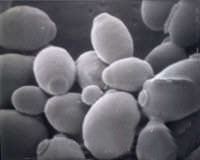Kingdom Fungi Scientific name Debaryomyces hansenii | Genus Debaryomyces Rank Species | |
 | ||
Similar Kluyveromyces, Meyerozyma guilliermondii, Kluyveromyces lactis, Pichia, Zygosaccharomyces | ||
Debaryomyces hansenii fungi kingdom
Debaryomyces hansenii is a species of yeast in the family Saccharomycetaceae.
Contents
- Debaryomyces hansenii fungi kingdom
- Ecology
- Nutritional requirements
- Reproduction
- Differentiation
- Biotechnology
- References
Ecology
Debaryomyces hansenii is an osmo-, halo-, xerotolerant, and non-pathogenic yeast found in hyper-saline waters such as the salterns on the Atlantic coast of Namibia or in the Great Salt Lake of Utah. D. hansenii is a common species in all types of cheese, including soft cheeses and the brines of semi-hard and hard cheeses. D. hansenii is also the most common yeast among 383 isolates from samples of unsulphited or sulphited sausages, skinless sausages and minced beef. The species produces toxins, including mycocins, to destroy competitive yeast species.
Nutritional requirements
The species can be cultivated in media with up to 25% NaCl or 18% glycerol. Growth rate increases in solutions with ≥ 1M NaCl or KCl, with sodium and potassium ions playing a very important role in the mechanisms involved in maintaining osmobalance. The species can survive a pH range between 3 and 10.
Reproduction
Most strains are haploid, mating very rarely and diploidize transiently by somatogamous autogamy (i.e. fusion of two cells but excluding their nuclei). Sexual reproduction proceeds via heterogamous conjugation (i.e. the conjugation of two cells of different form or size) leading to short diplophase followed by meiosis and ascospore formation. Haploid yeasts reproduce vegetatively by multilateral budding.
Differentiation
The ability of this species to grow at 10% NaCl or 5% glucose is used to discriminate D. hansenii from other ascomycetous yeasts. The species comprises two varieties: D. hansenii var. hansenii and var. fabryii. These two groups can be differentiated via rRNA, the electrophoretic mobility of their glucose-6-phosphate dehydrogenase, or by their maximum grow temperatures (35 °C for var. hansenii and 39 °C for var. fabryii).
Biotechnology
The species has been demonstrated to synthesize useful quantities of D-arabinitol, riboflavin, xylitol, and pyruvic acid under thiamine limitation. The species has also been used to decarboxylate Ferulic acid to 2-Methoxy-4-vinylphenol via biotransformation (a 95.07% yield, 1470.8 mg/l, within 10 hours).
